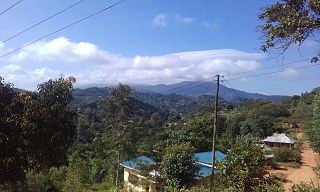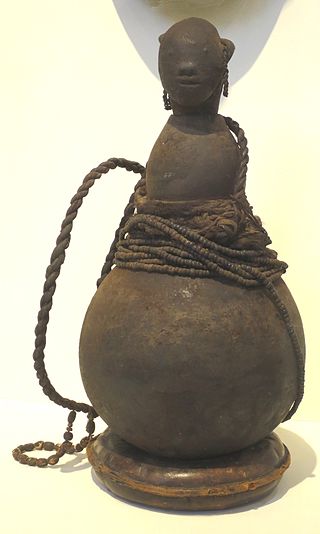Related Research Articles

The Chagga are a Nilotic ethnic group from Kilimanjaro Region of Tanzania and Arusha Region of Tanzania. They are the third-largest ethnic group in Tanzania. They historically lived in sovereign Chagga states on the slopes of Mount Kilimanjaro in both Kilimanjaro Region and eastern Arusha Region.

Kilimanjaro Region is one of Tanzania's 31 administrative regions. The regional capital and largest city is the municipality of Moshi. With the 3rd highest HDI of 0.640 in the country, Kilimanjaro is one among the top five most developed regions of Tanzania. According to the 2012 national census, the region had a population of 1,640,087, which was lower than the pre-census projection of 1,702,207. For 2002–2012, the region's 1.8 percent average annual population growth rate was the 24th highest in the country. It was also the eighth most densely populated region with 124 people per square kilometer. The most well-known tribes in the Kilimanjaro region are the chagga, rombos, and pare.

The Rendille are a Cushitic ethnic group inhabiting the Eastern Province of Kenya.
The Pare are a Bantu ethnic group. Their ancestral home is on the Pare Mountains of Same District and Mwanga District of Kilimanjaro Region in Northerneast Tanzania.

Taveta is the name of a tribe found in Kenya. It is also the name of the principal town in the land of the Taveta people and the name of the surrounding subdistrict of Kenya.
The Segeju are a Bantu ethnolinguistic group mostly based in Tanzania's Tanga Region and Kenya's Kwale County. Most Segeju reside in the small coastal strip between the Tanzanian city of Tanga and the Kenyan-Tanzanian border. However, some Segeju have migrated to urban areas in other parts of Tanzania or Kenya, in hopes of better employment opportunities and quality of life. Segeju migration to urban areas often results in severance of community ties, leading to a lack of transmission of important cultural traditions and language.

The Kuria people (also known as the AbaKurya, are a Bantu community in Tarime District of Mara Region in Tanzania and southern Kenya. Their homeland is bounded on the east by the Migori River and on the west by the Mara River estuary. Traditionally a pastoral and farming community, the Kuria grow maize, beans and cassava as food crops and coffee and maize as cash crops.
Gweno is a Bantu language spoken in the North Pare Mountains in the Kilimanjaro Region of Tanzania. The people known as the Gweno are a Chaga ethnic and linguistic group. Since the Chaga people are Bantu speakers, the adopted language contains dialects similar to that of the Kenyan language Kamba. Gweno shares about 54% to 56% of its vocabulary with other Chaga dialects and 46% with Taita dialects. However, a large percentage of its vocabulary is not seen in the other dialects. Also at the start of the 11th century, the Chaga people descended and migrated from the Bantu group in which they migrated to the foothills of mount Kilimanjaro. The Gweno language is today spoken mostly by older adults, with younger generations having shifted to Asu and Swahili. Ethnologue considers Gweno to be moribund; the language is not being passed down because children have not been exposed to Gweno since the 1970s. The generational shift from Gweno to either Asu or Swahili has certainly created shifts in dialect, however Gweno speakers do not see this as a threat.

The Embu or Aembu are a Bantu people indigenous to Embu county. The region is situated on the southern slopes of the former Eastern province. They belong to the northeastern Bantu branch and speak the Embu language known as Kiembu as a mother tongue. It belongs to the Bantu branch of the Niger-Congo family. Kimeru, Kikuyu, and Kikamba share similar language characteristics. To the west, Embu neighbours are the closely related Kikuyu in Kirinyaga, Nyeri, Kiambu, Muranga and Nyandarua counties. The Meru people border the Embu to the East.

The Eastern Arc Mountains are a chain of mountains found in Kenya and Tanzania. The chain runs from northeast to southwest, with the Taita Hills being in Kenya and the other ranges being in Tanzania. They are delimited on the southwest by the fault complex represented by the Makambako Gap that separates them from the Kipengere Range. To the northeast, they are delimited by more recent volcanism represented by Mount Kilimanjaro. The chain is considered a tentative World Heritage Site.
The Somali Bantus are a Bantu ethnic minority group in Somalia who primarily reside in the southern part of the country, primarily near the Jubba and Shabelle rivers. The Somali Bantus are descendants of enslaved peoples from various Bantu ethnic groups from Southeast Africa, particularly from Mozambique, Malawi, and Tanzania. The East African slave trade was not eliminated until the early parts of the 20th century.

The Nguni people are a linguistic cultural group of Bantu cattle herders who migrated from central Africa into Southern Africa, made up of ethnic groups formed from iron age and proto-agrarians, with offshoots in neighboring colonially-created countries in Southern Africa. Swazi people live in both South Africa and Eswatini, while Ndebele people live in both South Africa and Zimbabwe.

The Taita people are an ethnic group in Kenya's Taita-Taveta County. They speak Kidawida or Kitaita, which belongs to the Bantu language family. The West-Bantu migrated to the Taita-Taveta County around 1000-1300.

Lake Jipe is an inter-territorial lake straddling the borders of Kenya and Tanzania. On the Kenyan side, it is located south of the village of Nghonji while on the Tanzanian side, it is situated within Mwanga District, in Kilimanjaro Region. The lake is fed mainly by the Lumi River, which descends from Mount Kilimanjaro, as well as streams from the North Pare Mountains, being on the leeward side. The lake's outlet forms the Ruvu River. Kenya's unfenced Tsavo West National Park protects part of the lake's northern shore, while on the Tanzania side Mkomazi Game Reserve is nearby. The lake is known for its endemic fish, as well as water birds, mammals, wetland plants and lake-edge swamps, which can extend 2 kilometres (1.2 mi) from Jipe's shore.
Taita is a Bantu language spoken in the Taita Hills of Kenya. It is closely related to the Chaga languages of Kenya and Tanzania. The Saghala variety is distinct enough to be considered a language separate from the Daw'ida and Kasigau dialects.

Ugweno is located within the Mwanga District, Kilimanjaro Region, Tanzania, Africa. It is situated at 3° 39' 0" South and 37° 39' 0" East in the Pare Mountains. The people who live in Ugweno are known as Wagweno and their common language is Kigweno.

The eastern tree hyrax is a species of mammal within the family Procaviidae. The eastern tree hyrax is the most localized of the tree hyrax species, distributed patchily in a narrow band of lowland and montane forests in Kenya and Tanzania and adjacent islands.
The Lumbwa were a pastoral community which inhabited southern Kenya and northern Tanzania. The term Lumbwa has variously referred to a Kalenjin-speaking community, portions of the Maa-speaking Loikop communities since the mid-19th century, and to the Kalenjin-speaking Kipsigis community for much of the late 19th to mid-20th centuries.

The boundaries of this corridor can be defined within the Maasai territory. The corridor stretches from the Arusha Region, through the Kilimanjaro Region of Tanzania to the Taita-Taveta County of Kenya. To varying degrees, the people in this corridor are essentially a mixture of similar Bantu, Nilotic and Cushitic branches of the African people. The groups were dynamic, fluid and flexible. They shared a common history characterised by constant movement between the different areas for trade, battles, migration as well as social reasons. They were categorised arbitrarily by Europeans into the following culturally, linguistically and/or genetically related groups:

The Mbugu people, also known as the Va'maa, Ma'a are an ethnic Bantu and linguistic group hailing from western Usambara Mountains of Lushoto District in Tanga Region of Tanzania. Tanzania's Mbugu language is one of the few true hybrid languages, combining Bantu grammar with Cushitic lexicon. In actuality, the people speak two languages: one closely related to Pare and the other mixed. They are estimated to be around 60,000 Mbugu people left.
References
- 1 2 Chabay, Ilan; Frick, Martin; Helgeson, Jennifer (2015-10-08). Land Restoration: Reclaiming Landscapes for a Sustainable Future. Academic Press. p. 260. ISBN 978-0-12-801353-3.